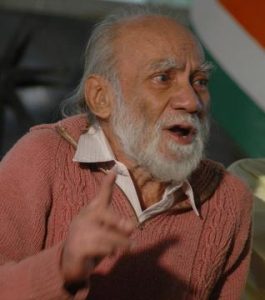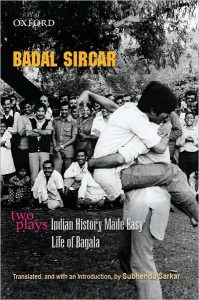Badal Sircar: The Epitome of Third Theatre
The man, who brought ‘Third Theatre’ to India, Badal Sircar is considered as a leading theatre director and playwright who constructed an epitome in Indian Theatre.
 B adal Sircar was one of the leading and most influential playwrights and directors in modern Indian theatre movement. He is the writer of more than fifty plays and recipient of Padma Shri, Sangeet Natak Akedemi Fellowship and Sangeet Natak Akedemi Award. Inspired by Grotowski and Euginio Barba, he started a new movement in the Indian theatre world, also known as ‘Third Theatre’.
B adal Sircar was one of the leading and most influential playwrights and directors in modern Indian theatre movement. He is the writer of more than fifty plays and recipient of Padma Shri, Sangeet Natak Akedemi Fellowship and Sangeet Natak Akedemi Award. Inspired by Grotowski and Euginio Barba, he started a new movement in the Indian theatre world, also known as ‘Third Theatre’.
With the advent of industrialisation leading to modernity, the working class became an essential element of metropolis populace. The word ‘mob’ associated with social and political revolution turned into ‘mass’/‘masses’, and the idea of revolution of the ‘mass’ became ‘heroic’. With rising popularity of Marxist aesthetics, artistes soon started to see themselves as labourers and their work as labour.
The conventional notions were broken, including rejection of institutions set up by status quo. New social, economic and cultural relations were approached which moved beyond boundaries set by the State; not only in terms of ideas but also in relation to form.
Badal Sircar emerged as a theatre director and writer who tried to emancipate himself and his work by crossing boundaries. He brought new ideas and methods to Indian theatre from the West and constructed a new form called the ‘Third Theatre’ coined by Barba to describe Odin Teatret.
Odin Teatret was the epitome model; constructed by people dedicated towards theatre. A small theatre society with diverse social and political ideas, it was also referred to as ‘small theatre’ or ‘Third Theatre’. Third Theatre saw itself as a cultural institution, trying to refine training and performance methods, but is perceived as avant-garde by many.
Barba endured to create a new theatrical language with renewed relationship between spectators, music and dance. As for him, mere spoken words restricted the reach of theatre. A conference on ‘Third Theatre’ gave the company its first amateur yet dedicated members who devised performances, without a hired playwright.
Sircar was also inspired by Polish theatre practitioner Jerzy Grotowski’s ‘The Poor Theatre’, who considered an actor’s body as the primary element in a theatre performance. Grotowski constructed a ‘theatre laboratory’ to experiment with the physical, spiritual and ritualistic elements of theatre. He tried to comprehend this acting style/system by turning to Indian Classical dance, Kathakali as well as yoga. For him, yoga remained inefficient, as it focused on interiority whereas actors required exteriority of emotions as well as gestures.
For him, gestures were to be expressive and dominant enough to overpower the lack which the form inhabits consciously. ‘Poor Theatre’ rejects the use of excess in theatre which includes lavish mis-en-scene, costumes, etc. The focus of the performance becomes actor’s body, which performs with minimalistic props. The process becomes simplistic and was performed in any space, thereby, rejecting traditional theatre halls or spaces.
 Coming of ‘Third Theatre’
Coming of ‘Third Theatre’
Sircar, professionally a town planner, never went through an official training in theatre. In the beginning of his theatre career, he could not remain stable and dwindled between theatre and town planning. Sircar, emerged as a great playwright in process of writing plays in which he could act. His first play was SolutionX written in 1956 based on the Hollywood film, ‘The Monkey Business’. The play was performed with people from his office named ‘Rehearsal Group’ and was started with no intention of performing on a formal stage.
Sircar, fascinated with comedies and science fiction fantasies wrote six plays which included Baro Pishima, Shonibar and Ram-Shyam-Jadu. But his play Ebong Indrajeet, written in 1960s opened gates of fame and popularity. The play was published in the journal of ‘Bahurupee’ and was performed by theatre group Shouvanik in 1965, while he was in Nigeria. With the new success in theatre, Sircar’s interest also grew and he got actively involved in theatre, starting his own group called ‘Satabdi’ with amateur performers willing to entertain middle class audience in the proscenium theatre. The rupture came, when Sircar started to grow over proscenium theatre and was invited by the Government of India to visit three European countries in 1969 where he encountered experimental theatre. This allowed Sircar to get introduced to Grotowski as well as Poor Theatre.
“For Sircar, poor theatre brought the theatre back to its ritualistic form, reduced to the unadorned body of performer.”
After his encounter with such ideas, the group started minimalistic use of sets, lights, costumes and even background music, completely rejecting mechanical and technological tools such as radio. Similar to Grotowski, the body of the actor experimented with mime, dance, movement, time, and space rather than speech. This new form was highly appreciated by the ‘mass’ audience as well as critics.
With these experiments in mind, Sircar adapted them to his previously written works. ‘Sparatcus’ became the first, which he wrote for proscenium theatre, based on Howard Fast’s novel. The process was closely associated as a workshop which explored capabilities of artistes.
His famed play ‘Spartacus’ became the route through which Sircar moved towards his destination to reach a concrete ‘Third Theatre’. To familiarise Indian theatre groups with his form, Sircar started to conduct theatre workshops in different regions of the country.
“The earliest workshop was conducted with the help of Indian art and theatre personality, Heisnam Kanhailal in 1972, which was an initiative of Manipur Sangeet Natak Akademi. A three-week long workshop was conducted on Spartacus, also translated in Manipuri with initiative given to performers to mould the performance.”
During the performance, the burst of energy by the slave characters became the high point for the local audiences, which they appreciated by spontaneous applause.
The revolt in the play was becoming the voice of the mass audience standing outside the fence. Performance was held in an open space under a wooden roof which invited local people and certain VIPs. For Sircar, selling tickets became turning audiences into consumers, thus it remained a practice to keep the tickets very cheap by reducing the cost of theatre, and also not relying on funds from government or other business houses. The reason for creating a ‘Third Theatre’ remains to enable interaction with audiences about role, responsibility and rights of citizens. Spartacus talks about the marginalised community and their exploitation. Such performance thus intrigues a desire to change, in the form of protest by giving a voice to the oppressed; not only by representation of the script by characters but also through form.
